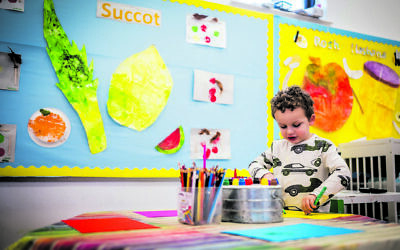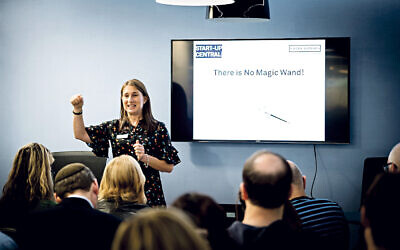René certainly had some Gaul
Francine Wolfisz finds out more about the life and work of René Goscinny, co-creator of the much-loved Astérix comics

During the golden age of comics, when American-Jewish artists used their immigrant experience to inspire the ultimate heroes in the guise of Superman, Spider-Man and the X-Men, one Jewish writer set out to create the exact opposite – with a pair of bumbling Gauls.
Astérix, diminutive in stature, but fearless in nature and his loyal friend, Obelix, oversized and ungainly with super-strength, were in many ways the archetypal “anti-heroes”, but just as beloved.
Now a new exhibition at the Jewish Museum London delves into the very reasons why Astérix still holds such an important place in the public imagination, with a retrospective on the life and work of its co-creator, René Goscinny.
Get The Jewish News Daily Edition by email and never miss our top stories Free Sign Up
Drawn by cartoonist Albert Uderzo, the adventures of Astérix, the ancient Gaul who called upon his friends to resist Roman occupation in 50BC, have sold more than 500 million books worldwide and been translated into 150 languages, as well as adapted into 100 films.
Goscinny was born in Paris in 1926 to Stanislaw, a chemical engineer from Poland, and Anna Bereśniak, originally from Ukraine.
He moved as a young child to Argentina, after Stanislaw found work there, but it was the Jewish family business back in France that curator Joanne Rosenthal believes had a lasting impact on Goscinny’s choice of career.
Pointing to a bookplate, one of the more than 100 exhibits including Goscinny’s typewriter, as well as letters, artworks, scripts and storyboards, Rosenthal explains: “The Beresniak printing works were a fixture of his childhood. They printed in Hebrew, Yiddish, Polish and French, and published everything from Bundist and Zionist materials to Jewish polemics and pamphlets.
“As a young child, Goscinny would have played with the printing blocks and been immersed in different languages.
“There’s perhaps no coincidence he ended up becoming a writer.”

In 1945, Goscinny, who showed an artistic flair from an early age, moved to New York in the hope of becoming a cartoonist.
He never made it in the US, but success came rapidly on his return to Europe, when he founded the Franco-Belgian magazine Pilote with Uderzo in 1959, debuting Astérix in the very first issue.

“Goscinny’s work was never explicitly Jewish, but his Jewishness was important to him, in terms of sticking up for the underdog and understanding himself as a minority,” continues Rosenthal.
“He was drawn to the outsider. He was born in France, grew up in Argentina, moved to New York and then came back to Europe. He had this very cosmopolitan outlook. That definitely finds its way into the subject matter of his cartoons, of people who are displaced, who are struggling and having a tough time.”
The exhibition features Goscinny’s other collaborations, including with Belgian cartoonist Maurice De Bevere (Morris), on Lucky Luke, as well as with French artist Sempé, with whom he created Le Petit Nicolas.

There are also examples of Little Fred and Big Ed, an early attempt to translate the
adventures of Astérix for the UK audience, by transplanting the well-known heroes from ancient Gaul to ancient Britain. The series never took off and instead became “an interesting historical footnote”.

In contrast, Astérix in its original form brought Goscinny lasting success.
“There is such warmth and humour in everything he did,” observes Rosenthal. “Even as a baby in his family photographs, he was always smirking. Humour was very important to him and so the joke count of the series was always very high.
“Astérix is unique in that its appeal spans across age ranges and works on different levels at the same time. People loved these comics when they were younger and come back to them again for the nostalgic value.”
Astérix in Britain: The Life and Work of René Goscinny runs at Jewish Museum London until 30 September. Details: jewishmuseum.org.uk

Thank you for helping to make Jewish News the leading source of news and opinion for the UK Jewish community. Today we're asking for your invaluable help to continue putting our community first in everything we do.
For as little as £5 a month you can help sustain the vital work we do in celebrating and standing up for Jewish life in Britain.
Jewish News holds our community together and keeps us connected. Like a synagogue, it’s where people turn to feel part of something bigger. It also proudly shows the rest of Britain the vibrancy and rich culture of modern Jewish life.
You can make a quick and easy one-off or monthly contribution of £5, £10, £20 or any other sum you’re comfortable with.
100% of your donation will help us continue celebrating our community, in all its dynamic diversity...
Engaging
Being a community platform means so much more than producing a newspaper and website. One of our proudest roles is media partnering with our invaluable charities to amplify the outstanding work they do to help us all.
Celebrating
There’s no shortage of oys in the world but Jewish News takes every opportunity to celebrate the joys too, through projects like Night of Heroes, 40 Under 40 and other compelling countdowns that make the community kvell with pride.
Pioneering
In the first collaboration between media outlets from different faiths, Jewish News worked with British Muslim TV and Church Times to produce a list of young activists leading the way on interfaith understanding.
Campaigning
Royal Mail issued a stamp honouring Holocaust hero Sir Nicholas Winton after a Jewish News campaign attracted more than 100,000 backers. Jewish Newsalso produces special editions of the paper highlighting pressing issues including mental health and Holocaust remembrance.
Easy access
In an age when news is readily accessible, Jewish News provides high-quality content free online and offline, removing any financial barriers to connecting people.
Voice of our community to wider society
The Jewish News team regularly appears on TV, radio and on the pages of the national press to comment on stories about the Jewish community. Easy access to the paper on the streets of London also means Jewish News provides an invaluable window into the community for the country at large.
We hope you agree all this is worth preserving.
-
By Brigit Grant
-
By Laurent Vaughan - Senior Associate (Bishop & Sewell Solicitors)
-
By Laurent Vaughan - Senior Associate (Bishop & Sewell Solicitors)
-
By Laurent Vaughan - Senior Associate (Bishop & Sewell Solicitors)
-
By Laurent Vaughan - Senior Associate (Bishop & Sewell Solicitors)





















